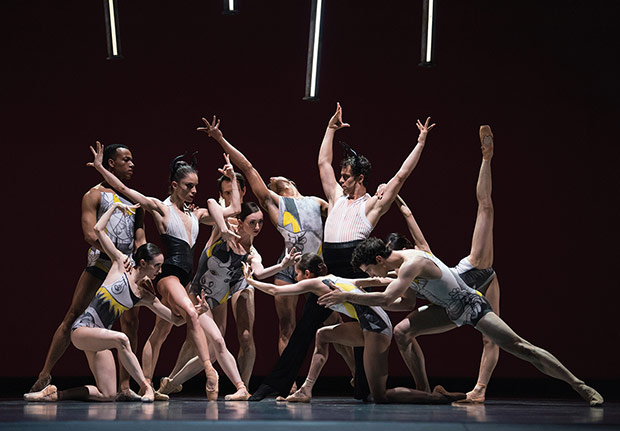
© Erik Tomasson. (Click image for larger version)
San Francisco Ballet
Unbound Festival Program C: Bespoke, Your Flesh Shall Be a Great Poem, Guernica
★★★★✰
San Francisco, War Memorial Opera House
24 April 2018
www.sfballet.org
Another night of riveting twenty-first century dance unfolded Tuesday at San Francisco Ballet – the opening of the Unbound Festival’s third program. Every work on the bill impressed with its freshness and ingenuity. Distinct tones, moods and compositional styles flooded the stage, as did many impactful performances. Program C’s offerings spanned the choreographic spectrum, from pure movement to narrative threads to inventive theatricality. If you have a taste for all three, as I do, Unbound’s Program C is just the ticket. It was also the first time I’ve ever been to a SF Ballet performance where recorded music was used in the majority of the work. But first up we got live – with Stanton Welch’s Bespoke set to two Bach violin concertos.

© Erik Tomasson. (Click image for larger version)
When new dance is set to centuries-old music, there’s often an assumption that the choreography is designed to fit into it, like a picture fitting into a picture frame. There are certainly examples of that, where the dynamics, speed and quality of the movement are somewhat determined by the score. But there are also many instances where the two can be in active dialogue, even though one is very old and the other, brand new. This was the case with Welch’s Bespoke. In the hands of SF Ballet’s phenomenal orchestra, (conducted here by David Briskin, with violin solos by Cordula Merks), Bach’s score was actively collaborating with Welch’s choreography.
In silence, Angelo Greco cycled through an academic ballet class sequence, changing facings, showing different positions of the body, legs moving off the floor into extension. With a huge buoyant jump to second position, the orchestra joined in with an equally vibrant energy. From there, the conversation between the two was off and running. The dance had made the first statement and the music had offered a response.
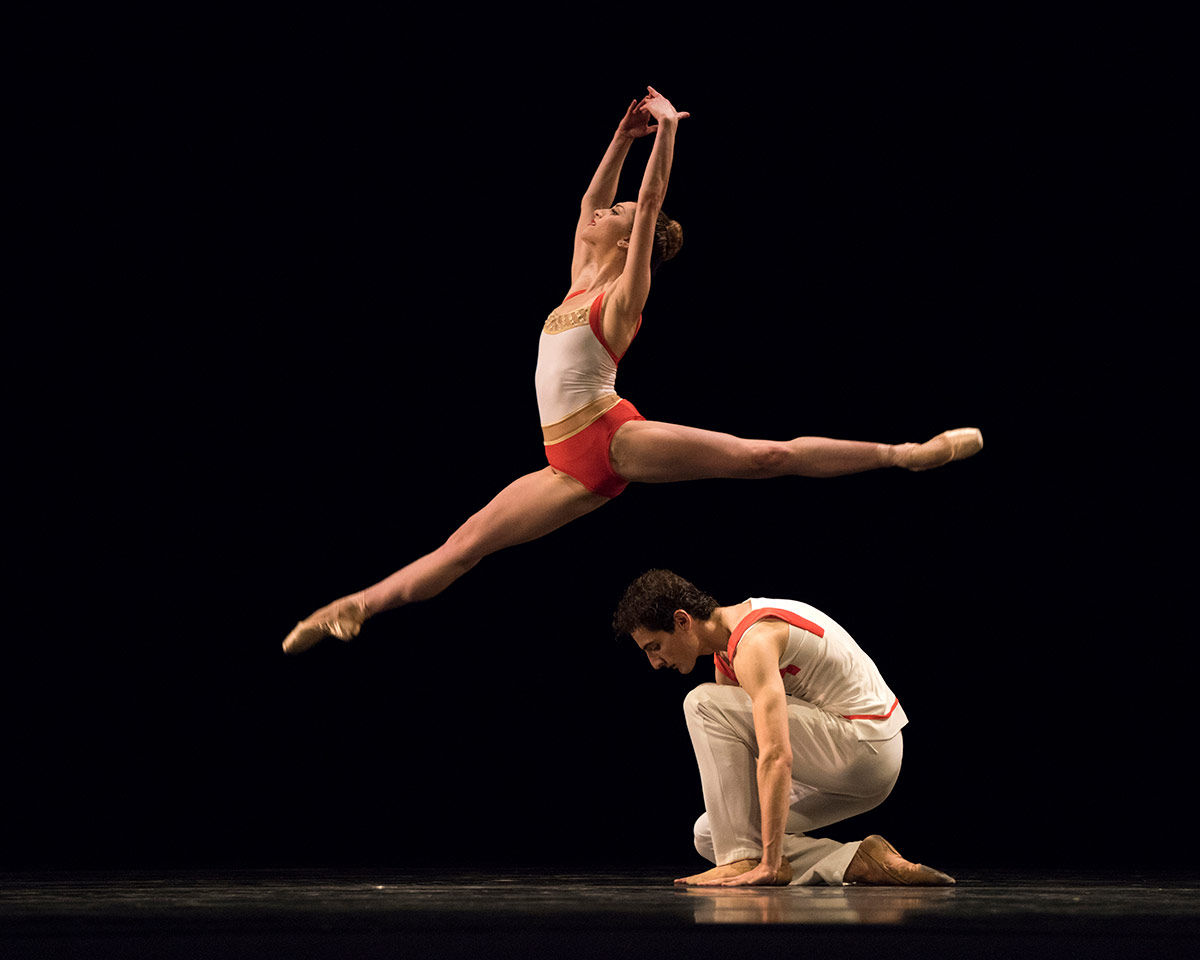
© Erik Tomasson. (Click image for larger version)
Interdependence was everywhere; individual ideas weaving together to create a layered whole. High treble voices entwined with the bass instruments as Bespoke’s dozen dancers snaked between each other on stage. Movement phrases had staggered starts; musical entrances similarly spaced out. And as different instruments began to leave the conversation, dancers peeled off from the stage action, one by one running towards the wings.
Bespoke’s richest section was the trio danced by Frances Chung, Sasha De Sola and Jennifer Stahl. In this pas de trois, Welch took a deep dive into fugal form (a common form for Bach), imbuing the choreography with its structural devices. First he experimented with fugal augmentation, when a motif’s rhythm gets faster. Chung, De Sola and Stahl started with the same movement at the same tempo. Then one of them would suddenly speed things up, while the others remained steady. The reverse also happened (fugal diminution) where slower versions of a step were juxtaposed against its original tempo. Bespoke was a marvelous start to Program C, its only challenge being that with a number of slow sections towards the end, the energy lagged a bit.

© Erik Tomasson. (Click image for larger version)
I have to admit that I don’t always refer to program notes before a dance performance. Don’t get me wrong. I’m definitely someone who’s interested in background and context. But from time to time, I think it’s valuable to see dance free of framing. See what resonates in the moment. In those instances, I will often read the notes after the fact, which is what I did with Trey McIntyre’s Your Flesh Shall Be a Great Poem. In that post-performance reading, I learned that the work is personal, familial, about McIntyre’s grandfather. When I was watching it, I may not have known who the ballet was about, but the human journey Flesh traversed was undeniable. Its layered narrative collage, danced by a cast of nine, communicated a range of emotion and connection.

© Erik Tomasson. (Click image for larger version)
Flesh had an epic start, almost cinematic. The curtain rose ever so slowly, like an old-school movie where the credits come at the beginning rather than at the end. A bright moon illuminated the backdrop. With a distinctly frontier feel, Reid Bartelme and Harriet Jung’s costumes placed the action back in time; Chris Garneau’s folksy recorded score lilted through the air, like trees rustling in the wind. What followed was a suite of dance vignettes (each one set to a different Garneau selection) where multiple aspects of the human condition were explored.
Solo work factored heavily in Flesh, which made sense considering the dance had a protagonist. Skillfully interpreted by Benjamin Freemantle, it was the emotional quality of the solos that really struck. Particularly the feeling of absence. Alone on the stage, Freemantle looked out into space, his gaze fixed longingly on the horizon. You could feel that something was missing. Was he yearning for connection, searching for connection or remembering a connection from the past? While I enjoyed these solos, I actually felt that Flesh’s emotional breadth was conveyed more strongly in the dance’s small groupings. Two dancers faced front, near each other, but not touching. Their hands softly covered their hearts, then their mouths; an attempt to transfer their feelings into words. Their arms reached for each other, but they were unable, or maybe even unwilling, to make contact. The distance between them, whether literal or figurative, was too great. But Flesh wasn’t all heaviness. Plucky staccato footwork brought joy to the table. High soaring lifts and jumps in Isabella DeVivo and Steven Morse’s pas de deux, elation and excitement.

© Erik Tomasson. (Click image for larger version)
Powerful. Aggressive. Confronting. All are apt descriptors for Annabelle Lopez Ochoa’s pulsating Guernica. Inspired by Pablo Picasso’s 1937 masterwork of the same title, the ensemble work for sixteen was filled with themes from the famous painting. Mark Zappone reflected it in his costume design, using a palette of black, white, cream and grey, and fashioning bull horn headpieces for the two lead couples (a bull is featured on one side of the art). Choreographically, heads rolled up to the right and then up to the left, also evoking the bull, while strong geometric lines informed much of the syntax – angular shapes, sharp edges, extreme splits. And every motion, pose and circuit had an unmistakable, almost violent, attack.
When you look at the Picasso, it’s impossible to ignore the fracturing and fragmentation of the images (a known tenet of the Cubist style). Ochoa brilliantly infused this state into Guernica’s choreographic patterns. The cast would circle out and away from the center, the scene inexplicably breaking into pieces. Multiple entrances and exits throughout the dance made it feel like the landscape was constantly forming and re-forming. And Ochoa took phrase material off of pointe to demi-pointe to break the line of the leg. The hard quality of Guernica’s recorded electronic score was definitely fitting, though a couple of sequences were too grating for too long.
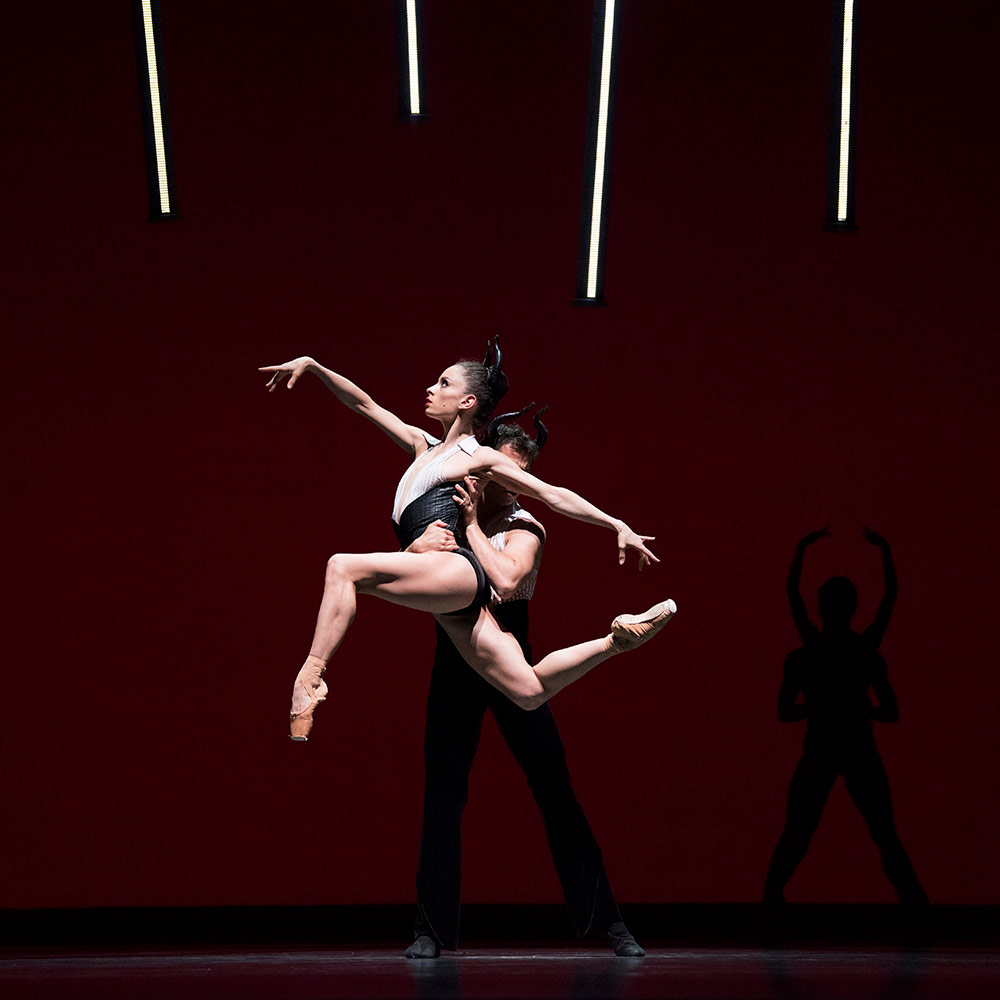
© Erik Tomasson. (Click image for larger version)
As Guernica reached its conclusion, the mood shifted. The final pas de deux (danced by Dores André and Vitor Luiz) still had a strong intensity, but Ochoa layered in a kind of softness and suspension too. It was a beautiful moment of counterpoint. And appropriately, the music also shifted (just in time for me) to a lyrical piano solo, performed live by Ronny Michael Greenberg.














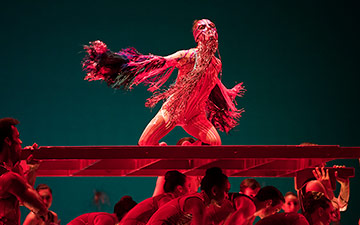
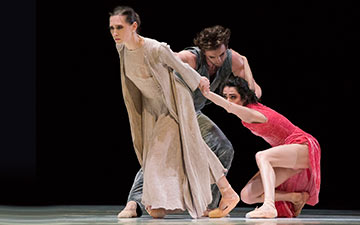

You must be logged in to post a comment.